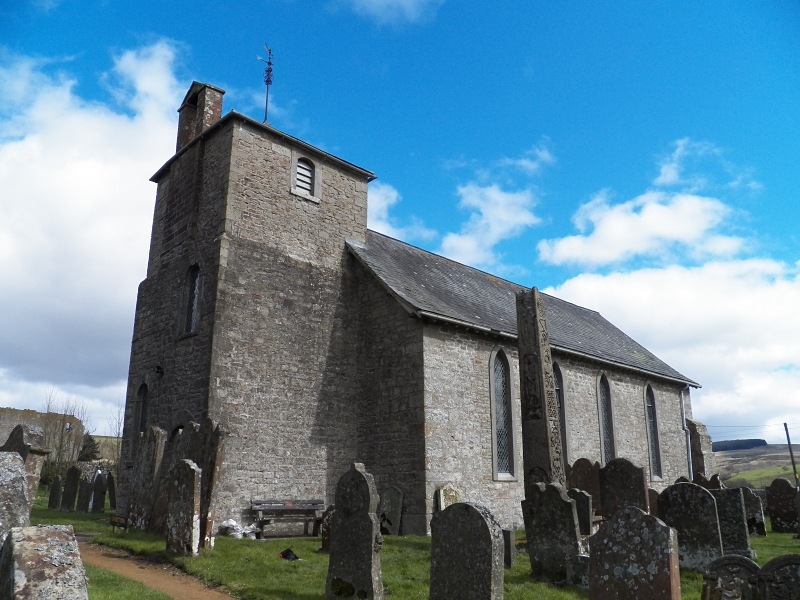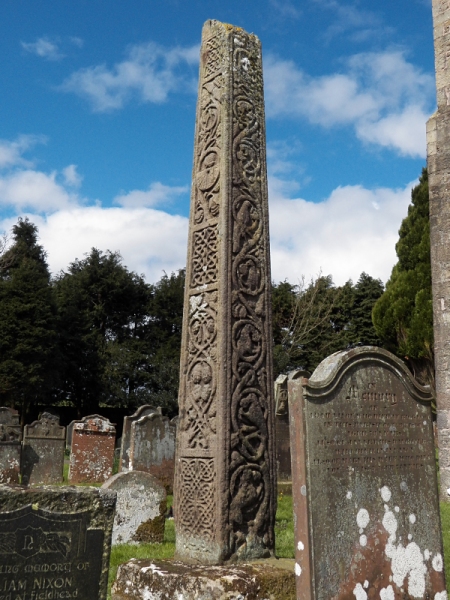
The road is forested on either side, and rays of sunlight slant down through the foliage as we return to England, driving east toward Bewcastle, in Cumbria, site of a runic cross. Winding past a farm, we stop and look out on the ruins of a castle, whose stone had obviously been pillaged to build the farmhouse and barn.
This is a very remote and isolated area but does not have the desolate feel of Brough. Despite outward appearances, it conveys a flinty tenacity; it's unyielding; tough. We pass a field full of cows unlike any cows I've seen before. They are short limbed and stocky and, though not exactly like the pictures of Highland cattle I've seen, a little shaggy.
These are the descendants of the border cattle over which so much blood was shed in the past. I consider taking a picture to show to my children, but these cows look angry and are awfully close to the road. Instinct tells me to save my film for the churchyard and cross which are just across the road.
A service is in progress inside the church; we can hear a voice and then music and more voices raised in song. Quietly and carefully we weave our way through the gravestones toward the yellow sandstone cross. The shaft that remains towers over me and is elaborately carved with Biblical figures on one side and a tree, fruit, birds, animals, and knotwork on the others.
I circle around and around amazed at the detail. The stone is rough and cool under my fingertips as I feel the ridges and depressions that make up the designs. Also within the churchyard is a small exhibition building which is very educational. A mural takes up one entire wall; a wonderfully colorful portrait incorporating Romans and reivers, landscape and wildlife. There is also a small display written and illustrated by local schoolchildren relating the history of the area.
One of the three Roman outpost forts built to the north of Hadrian's Wall, Bewcastle was abandoned by the Romans by 367AD and occupied by the Angles. By the time of the Norman Conquest the area was in the hands of a Saxon by the name of Bueth, who probably occupied the remains of the castle, and from whom the name Bewcastle is derived.
The cross dates from the late 7th or early 8th century. The inscription suggests that it was a memorial to Alchfrith, son of Oswiu of Northumbria, and his wife Cyneburh. Using stone from the Roman fort, the church, which is now called St. Cuthbert's, was built during the reign of Edward I. From the 14th through the 17th centuries Bewcastle was the hub of reiving activities with many routes crossing the parish. During this period of great unrest, the parish was laid to waste several times.
This is a very stirring visit for me. I am torn between wonder at the span of history that is so evident in the ravaged castle and monument, and sorrowful resignation due to the violence that has occurred here. The heathen in me is also a bit uncomfortable, since I haven't stepped foot inside a church to attend a service in almost thirty years, and here I am stomping around this churchyard for my own pleasure, while devout and purposeful souls sit inside and pray. We leave as quietly as we arrived.

Bewcastle is a large civil parish in the City of Carlisle district of Cumbria. To the north the parish extends to the border with Scotland, and to the east it bounds Northumberland.
St Cuthbert's churchyard contains the famous 7th Century Bewcastle Cross. The sundial on its surface is the oldest in Britain, divided into the four 'tides' which governed the working day in medieval times.
Bewcastle is also known for its unusual hexagonal Roman fort, which has been identified as Fanum Cocidi; its grassy ramparts can still be seen surrounding the churchyard. The fort was originally built as an outlying defense of Hadrian's Wall to the south, to which it was linked by a road direct from the Roman fort of Birdoswald on the wall.
Read more about Bewcastle at Wikipedia.